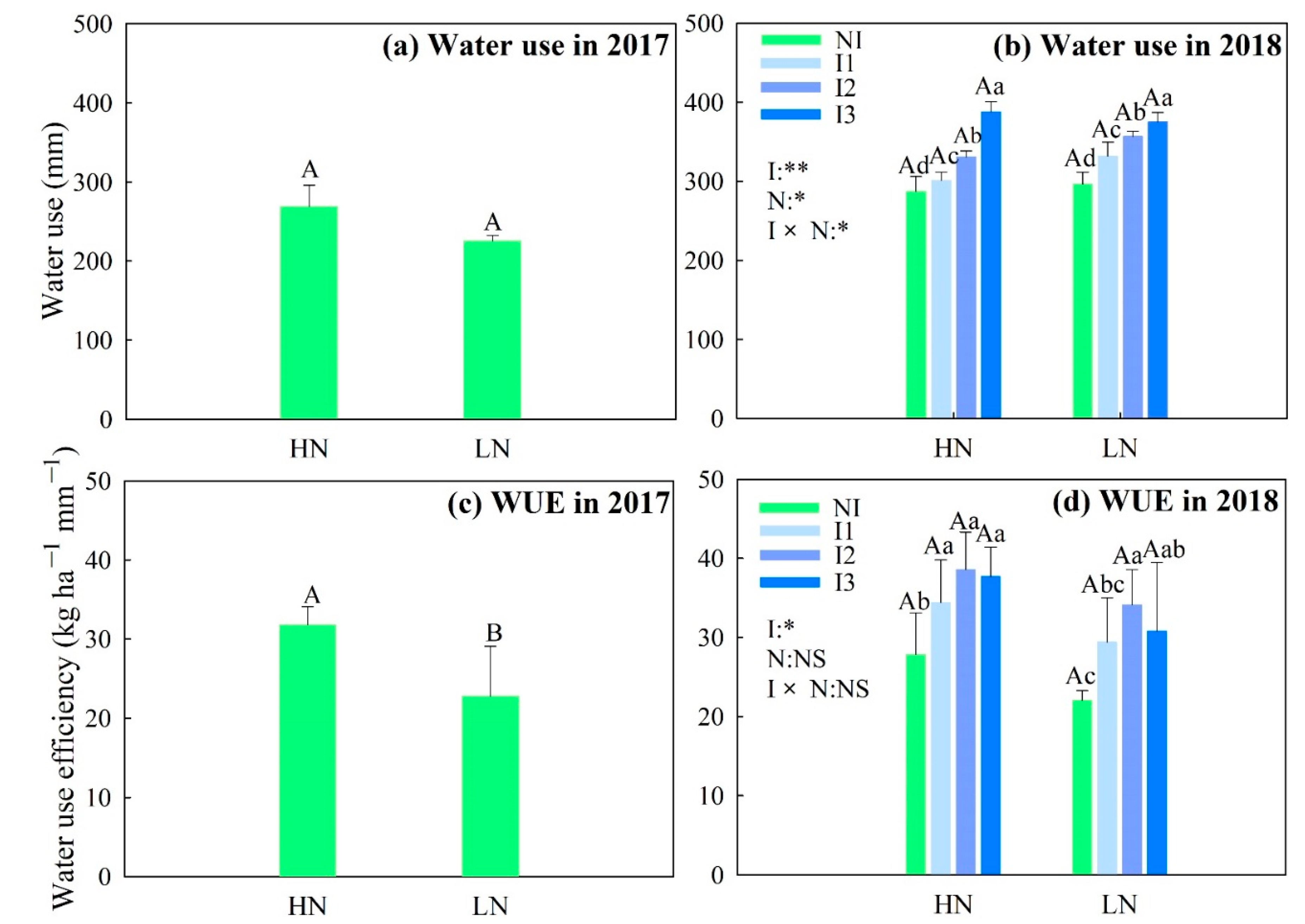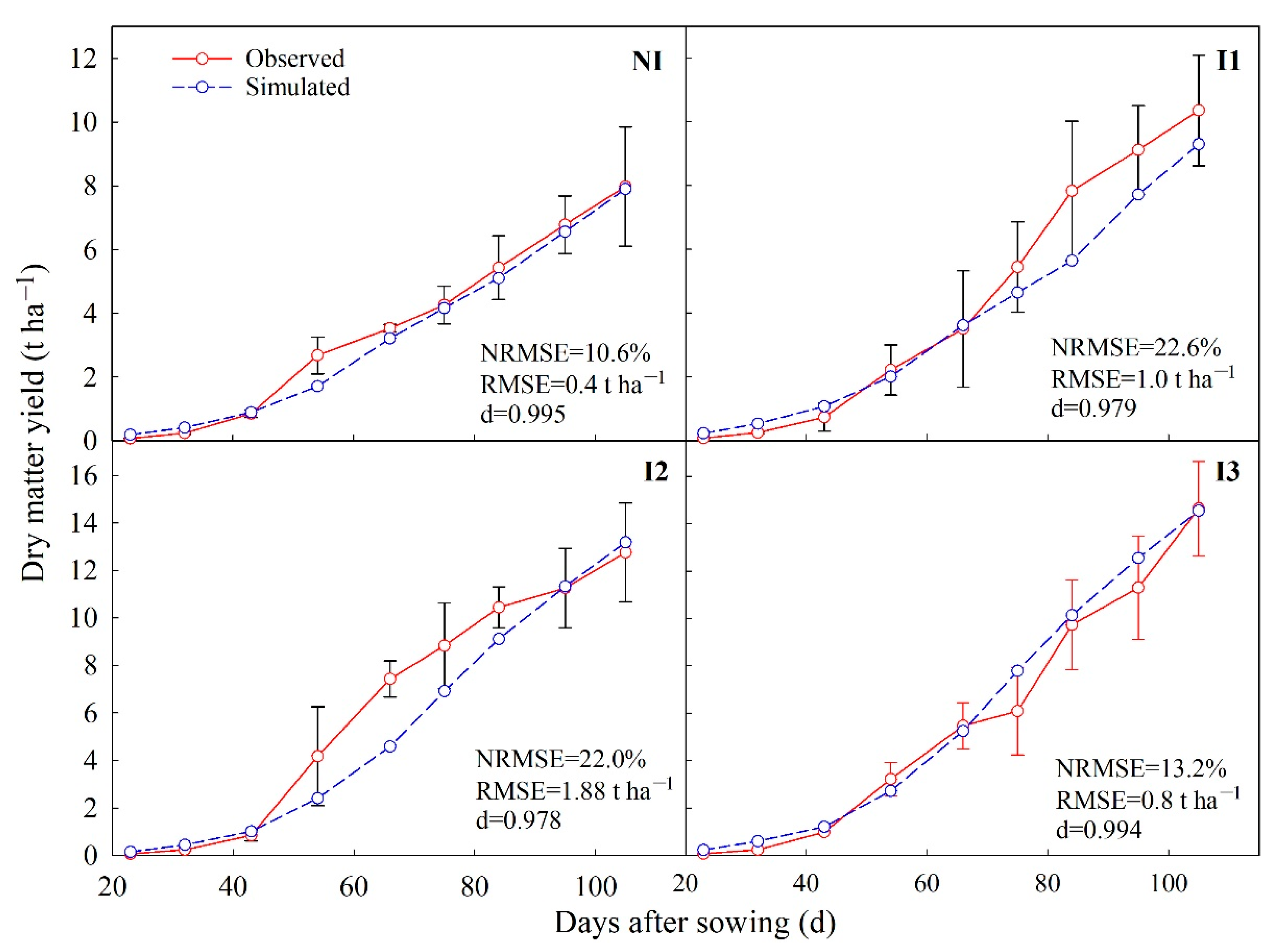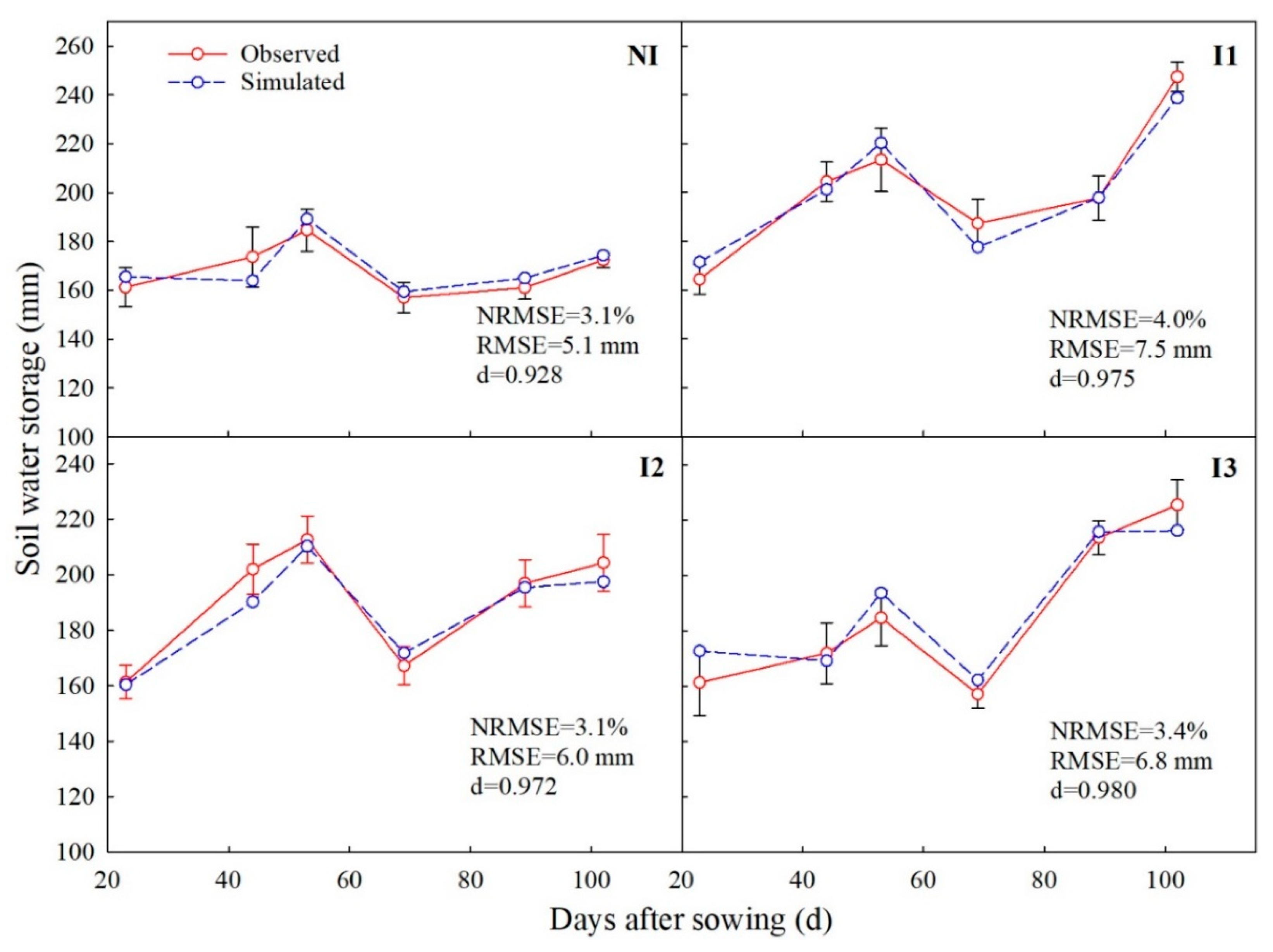Optimizing Water and Nitrogen Strategies to Improve Forage Oat Yield and Quality on the Tibetan Plateau Using APSIM
Abstract
:1. Introduction
2. Materials and Methods
2.1. Experimental Site
2.2. Experimental Design and Field Management
2.3. Measurements and Calculations
2.3.1. Phenology Stages and Dry Matter Yield
2.3.2. Soil Water Content
2.3.3. Water Use and WUE
2.3.4. Nitrogen Use Efficiency
2.4. APSIM Parameterization and Validation
2.5. Scenario Analysis
2.6. Statistical Analysis
3. Results
3.1. Experiment Results
3.1.1. Oat Dry Matter Yield
3.1.2. Water Use and WUE
3.1.3. N Uptake and NUE
3.2. APSIM Calibration and Validation
3.2.1. Model Calibration
3.2.2. Model Validation
3.3. Optimization of Irrigation and Nitrogen Applications
4. Discussion
4.1. Biomass Yield, Water Use, and Nitrogen Use of Oat in the Field Experiment
4.2. APSIM Performance and Scenario Analysis
5. Conclusions
Author Contributions
Funding
Data Availability Statement
Conflicts of Interest
References
- Long, R.; Zhang, D.; Wang, X.; Hu, Z.; Dong, S. Effect of strategic feed supplementation on productive and reproductive performance in yak cows. Prev. Vet. Med. 1999, 38, 195–206. [Google Scholar] [CrossRef]
- Harris, R.B. Rangeland degradation on the Qinghai-Tibetan plateau: A review of the evidence of its magnitude and causes. J. Arid Environ. 2010, 74, 1–12. [Google Scholar] [CrossRef]
- Brown, C.; Waldron, S. Agrarian change, agricultural modernization and the modelling of agricultural households in Tibet. Agric. Syst. 2013, 115, 83–94. [Google Scholar] [CrossRef]
- Dong, S.; Shang, Z.; Gao, J.; Boone, R.B. Enhancing sustainability of grassland ecosystems through ecological restoration and grazing management in an era of climate change on Qinghai-Tibetan Plateau. Agric. Ecosyst. Environ. 2020, 287, 106684. [Google Scholar] [CrossRef]
- Li, R.; Zhang, Z.; Tang, W.; Huang, Y.; Coulter, J.A.; Nan, Z. Common vetch cultivars improve yield of oat row intercropping on the Qinghai-Tibetan plateau by optimizing photosynthetic performance. Eur. J. Agron. 2020, 117, 126088. [Google Scholar] [CrossRef]
- Wang, Z.; Zhang, X.; Ma, Q.; Shen, Y. Seed mixture of oats and common vetch on fertilizer and water-use reduction in a semi-arid alpine region. Soil Till. Res. 2022, 219, 105329. [Google Scholar] [CrossRef]
- Zhao, G.; Shi, S.; Liu, G.; Xu, S. The current situation of oat research and production, problems and strategy in Tibetan Plateau. Pratacultural Sci. 2004, 21, 17–21. [Google Scholar]
- Guo, J.; Liu, X.; Zhang, Y.; Shen, J.; Han, W.; Zhang, W.; Christie, P.; Goulding, K.; Vitousek, P.; Zhang, F. Significant acidification in major Chinese croplands. Science 2010, 327, 1008–1010. [Google Scholar] [CrossRef] [Green Version]
- Zhao, X.; Zhou, Y.; Min, J.; Wang, S.; Shi, W.; Xing, G. Nitrogen runoff dominates water nitrogen pollution from rice-wheat rotation in the Taihu Lake region of China. Agric. Ecosyst. Environ. 2012, 156, 1–11. [Google Scholar] [CrossRef]
- Zhang, K.; Chen, Y.; Zhang, P.; Wei, K.; Yang, J. Differences in yield of oat varieties and relationship with agronomic traits under irrigation conditions. Agric. Res. Arid Areas 2019, 37, 166–170. [Google Scholar]
- Xu, B.; Tang, P.; Li, Q.; Yixi, Z.; Ren, Q. Research on optimal irrigation schedule of oats by CROPWAT in Lhasa of Tibet. Agric. Res. Arid Areas 2015, 33, 35–39. [Google Scholar]
- Zhao, B.; Pang, Y.; Zeng, Z.; Hu, Y.; Li, G.; Liu, R. Effect of limited irrigation on yield and water use efficiency of oats. Agric. Res. Arid Areas 2007, 25, 105–108. [Google Scholar]
- Chai, Q.; Gan, Y.; Zhao, C.; Xu, H.; Waskom, R.M.; Niu, Y.; Siddique, K.H. Regulated deficit irrigation for crop production under drought stress. A review. Agron. Sustain. Dev. 2016, 36, 3. [Google Scholar] [CrossRef] [Green Version]
- Jia, Z.; Zhou, Q.; Han, Z.; Yan, H. Effect of N and P fertilizer on the production performance of bare buried. Pratacultural Sci. 2007, 24, 19–22. [Google Scholar]
- Gao, K.; Yu, Y.; Xia, Z.; Ling, L. Response of height, dry matter accumulation and partitioning of oat (Avena sativa L.) to planting density and nitrogen in Horqin Sandy Land. Sci. Rep. 2019, 9, 7961. [Google Scholar] [CrossRef] [Green Version]
- May, W.E.; Brandt, S.; Hutt Taylor, K. Response of oats grain yield and quality to nitrogen fertilizer and fungicides. Agron. J. 2020, 112, 1021–1034. [Google Scholar] [CrossRef] [Green Version]
- Kibe, A.M.; Singh, S.; Kalra, N. Water–nitrogen relationships for wheat growth and productivity in late sown conditions. Agric. Water Manag. 2006, 84, 221–228. [Google Scholar] [CrossRef]
- Zhou, S.; Hu, X.; Ran, H.; Wang, W.; Hansen, N.; Cui, N. Optimization of irrigation and nitrogen fertilizer management for spring maize in northwestern China using RZWQM2. Agric. water Manag. 2020, 240, 106276. [Google Scholar] [CrossRef]
- Araya, A.; Prasad, P.V.V.; Gowda, P.H.; Afewerk, A.; Abadi, B.; Foster, A.J. Modeling irrigation and nitrogen management of wheat in northern Ethiopia. Agric. water Manag. 2019, 216, 264–272. [Google Scholar] [CrossRef]
- Kadiyala, M.D.M.; Jones, J.W.; Mylavarapu, R.S.; Li, Y.C.; Reddy, M.D. Identifying irrigation and nitrogen best management practices for aerobic rice–maize cropping system for semi-arid tropics using CERES-rice and maize models. Agric. Water Manag. 2015, 149, 23–32. [Google Scholar] [CrossRef] [Green Version]
- Cao, X.; Wu, L.; Lu, R.; Zhu, L.; Zhang, J.; Jin, Q. Irrigation and fertilization management to optimize rice yield, water productivity and nitrogen recovery efficiency. Irrig. Sci. 2021, 39, 235–249. [Google Scholar] [CrossRef]
- Giannoulis, K.D.; Kamvoukou, C.; Gougoulias, N.; Wogiatzi, E. Irrigation and nitrogen application affect Greek oregano (Origanum vulgare ssp. hirtum) dry biomass, essential oil yield and composition. Ind. Crops Prod. 2020, 150, 112392. [Google Scholar] [CrossRef]
- Zhang, Y.; Zhang, L.; Yang, N.; Huth, N.; Wang, E.; van der Werf, W.; Evers, J.B.; Wang, Q.; Zhang, D.; Wang, R.; et al. Optimized sowing time windows mitigate climate risks for oats production under cool semi-arid growing conditions. Agric. For. Meteorol. 2019, 266–267, 184–197. [Google Scholar] [CrossRef]
- Keating, B.A.; Carberry, P.S.; Hammer, G.L.; Probert, M.E.; Robertson, M.J.; Holzworth, D.; Huth, N.I.; Hargreaves, J.N.G.; Meinke, H.; Hochman, Z.; et al. An overview of APSIM, a model designed for farming systems simulation. Eur. J. Agron. 2003, 18, 267–288. [Google Scholar] [CrossRef] [Green Version]
- Beah, A.; Kamara, A.Y.; Jibrin, J.M.; Akinseye, F.M.; Tofa, A.I.; Adam, A.M. Simulating the Response of Drought–Tolerant Maize Varieties to Nitrogen Application in Contrasting Environments in the Nigeria Savannas Using the APSIM Model. Agronomy 2021, 11, 76. [Google Scholar] [CrossRef]
- Lu, Y.; Wang, E.; Zhao, Z.; Liu, X.; Tian, A.; Zhang, X. Optimizing irrigation to reduce N leaching and maintain high crop productivity through the manipulation of soil water storage under summer monsoon climate. Field Crops Res. 2021, 265, 108110. [Google Scholar] [CrossRef]
- Ma, Q.; Zhang, X.; Wang, Z.; Yang, H. Optimizing oat irrigation schedules in an alpine region using APSIM. Acta Prataculturae Sin. 2020, 29, 1–10. [Google Scholar]
- Large, E.C. Growth Stages in Cereals Illustration of the Feekes Scale. Plant Pathol. 1954, 3, 128–129. [Google Scholar] [CrossRef]
- Wang, Z.; Jiang, H.; Shen, Y. Forage production and soil water balance in oat and common vetch sole crops and intercrops cultivated in the summer-autumn fallow season on the Chinese Loess Plateau. Eur. J. Agron. 2020, 115, 126042. [Google Scholar] [CrossRef]
- Holzworth, D.P.; Huth, N.I.; DeVoil, P.G.; Zurcher, E.J.; Herrmann, N.I.; McLean, G.; Chenu, K.; van Oosterom, E.J.; Snow, V.; Murphy, C.; et al. APSIM—Evolution towards a new generation of agricultural systems simulation. Environ. Model. Softw. 2014, 62, 327–350. [Google Scholar] [CrossRef]
- Priestley, C.H.B.; Taylor, R.T. On the assessment of surface heat flux and evaporation using large-scale parameters. Mon. Weather Rev. 1972, 100, 81–92. [Google Scholar] [CrossRef]
- Ritchie, J.T. Model for predicting soil evaporation from row crop with incomplete cover. Water Resour. Res. 1972, 8, 1204–1213. [Google Scholar] [CrossRef] [Green Version]
- Allen, R.G.; Pereira, L.S.; Raes, D.; Smith, M. Crop Evapotranspiration: Guidelines for Computing Crop Water Requirements; FAO Irrigation and Drainage Paper 56; FAO: Rome, Italy, 1998. [Google Scholar]
- Ahmed, M.; Akram, M.N.; Asim, M.; Aslam, M.; Hassan, F.; Higgins, S.; Stöckle, C.O.; Hoogenboom, G. Calibration and validation of APSIM-Wheat and CERES-Wheat for spring wheat under rainfed conditions: Models evaluation and application. Comput. Electron. Agr. 2016, 123, 384–401. [Google Scholar] [CrossRef]
- Jamieson, P.D.; Porter, J.R.; Wilson, D.R. A test of the computer simulation model ARCWHEAT1 on wheat crops grown in New Zealand. Field Crops Res. 1991, 27, 337–350. [Google Scholar] [CrossRef]
- Willmott, C.J.; Ackleson, S.G.; Davis, R.E.; Feddema, J.J.; Klink, K.M.; Legates, D.R.; O’Donnell, J.; Rowe, M. Statistics for the evaluation and comparison of models. J. Geophys. Res. Oceans 1985, 90, 8995–9005. [Google Scholar] [CrossRef] [Green Version]
- Neugschwandtner, R.W.; Kaul, H.P. Nitrogen uptake, use and utilization efficiency by oat-pea intercrops. Field Crops Res. 2015, 179, 113–119. [Google Scholar] [CrossRef]
- Cui, J.; Yang, H.; Yu, C.; Bai, S.; Wu, T.; Song, S.; Sun, W.; Shao, X.; Jiang, L. Effect of urea fertilization on biomass yield, chemical composition, in vitrorumen digestibility and fermentation characteristics of forage oats straw in Tibet of China. J. Agric. Sci. 2016, 154, 914–927. [Google Scholar] [CrossRef]
- Khan, S.; Anwar, S.; Shaobo, Y.; Gao, Z.; Sun, M.; Ashraf, M.Y.; Ren, A.; Yang, Z. Soil water consumption, water use efficiency and winter wheat production in response to nitrogen fertilizer and tillage. Peer J. 2020, 8, e8892. [Google Scholar] [CrossRef]
- Palestina, M.S.; Gutierrez, R.A.S.; Valle, O.R.; Reyes, M.A.G.; Banuelos, H.G. Models for irrigation timing and optimization in oats for forage. Rev. Mex. Cienc. Pecu. 2018, 9, 667–684. [Google Scholar]
- Wang, Q.; Li, F.; Zhang, E.; Li, G.; Vance, M. The effects of irrigation and nitrogen application rates on yield of spring wheat (longfu-920) and water use efficiency and nitrate nitrogen accumulation in soil. Aust. J. Crop Sci. 2012, 6, 662–672. [Google Scholar]
- Qiu, G.Y.; Wang, L.; He, X.; Zhang, X.; Chen, S.; Chen, J.; Yang, Y. Water use efficiency and evapotranspiration of winter wheat and its response to irrigation regime in the north China plain. Agric. For. Meteorol. 2008, 148, 1848–1859. [Google Scholar] [CrossRef]
- Bassu, S.; Asseng, S.; Motzo, R.; Giunta, F. Optimising sowing date of durum wheat in a variable Mediterranean environment. Field Crops Res. 2009, 111, 109–118. [Google Scholar] [CrossRef]
- Mohanty, M.; Probert, M.E.; Reddv, K.S.; Dalal, R.C.; Mishra, A.K.; Rao, A.S.; Sinh, M.; Menzies, N.W. Simulating soybean-wheat cropping system: APSIM model parameterization and validation. Agric. Ecosyst. Environ. 2012, 152, 68–78. [Google Scholar] [CrossRef]
- Yang, X.; Zheng, L.; Yang, Q.; Wang, Z.; Cui, S.; Shen, Y. Modelling the effects of conservation tillage on crop water productivity, soil water dynamics and evapotranspiration of a maize-winter wheat-soybean rotation system on the Loess Plateau of China using APSIM. Agric. Syst. 2018, 166, 111–123. [Google Scholar] [CrossRef]
- Vogeler, I.; Cichota, R.; Thomsen, I.K.; Bruun, S.; Jensen, L.S.; Pullens, J.W.M. Estimating nitrogen release from Brassicacatch crop residues-Comparison of different approaches within the APSIM model. Soil Till. Res. 2019, 195, 104358. [Google Scholar] [CrossRef]
- Yang, X.; Li, Z.; Cui, S.; Cao, Q.; Deng, J.; Lai, X.; Shen, Y. Cropping system productivity and evapotranspiration in the semi-arid Loess Plateau of China under future temperature and precipitation changes: An APSIM-based analysis of rotational vs. continuous systems. Agric. water Manag. 2020, 229, 105959. [Google Scholar] [CrossRef]
- Frasier, I.; Noellemeyer, E.; Amiotti, N.; Quiroga, A. Vetch-rye biculture is a sustainable alternative for enhanced nitrogen availability and low leaching losses in a no-till cover crop system. Field Crops Res. 2017, 214, 104–112. [Google Scholar] [CrossRef]
- Zhao, J.; Cai, X.; Wang, Z. Optimality conditions for a two-stage reservoir operation problem. Water Resour. Res. 2011, 47, W08503. [Google Scholar] [CrossRef]
- Baxevanos, D.; Tsialtas, I.T.; Voulgari, O.; Pankou, C.I.; Vlachostergios, D.; Lithourgidis, A.S. Oat genotypic requirement for intercropping with vetch under Mediterranean conditions. J. Agric. Sci. 2020, 158, 695–706. [Google Scholar] [CrossRef]
- Chu, G.; Yang, L. Study on effect of deficit irrigation on the yield and water use efficiency in winter wheat. Water-Sav. Irrig. 2016, 8, 54–56. [Google Scholar]
- Kang, X.; Jing, H.; Ma, A.; Wang, Y.; Cui, H. Effects of micro-sprinkler irrigation amounts on soil water storage and consumption and water use efficiency in the north of Huang-Huai-Hai wheat field. J. Soil Water Cons. 2019, 33, 221–226. [Google Scholar]
- Lukangu, G.; Savage, M.J.; Johnston, M.A. Use of sub-hourly soil water content measured with a frequency-domain reflectometer to schedule irrigation of cabbages. Irrig. Sci. 1999, 19, 7–13. [Google Scholar] [CrossRef]
- Abraha, M.G.; Savage, M.J. The soil water balance of rainfed and irrigated oats, Italian ryegrass and rye using the CropSyst model. Irrig. Sci. 2008, 26, 203–212. [Google Scholar] [CrossRef]









| Soil Layer (cm) | Soil Organic Matter (g·kg−1) | Available Nitrogen (mg·kg−1) | Available Phosphorus (mg·kg−1) | Bulk Density (g·cm−3) | Field Water Capacity (cm3·cm−3) | Crop Low Limit (cm3·cm−3) |
|---|---|---|---|---|---|---|
| 0–10 | 19.92 | 23.82 | 6.11 | 1.38 | 0.27 | 0.09 |
| 10–20 | 20.90 | 13.58 | 5.43 | 1.39 | 0.26 | 0.09 |
| 20–30 | 24.74 | 10.09 | 5.56 | 1.40 | 0.27 | 0.08 |
| 30–40 | 15.30 | 6.83 | 2.93 | 1.42 | 0.26 | 0.07 |
| 40–60 | 10.60 | 4.76 | 2.18 | 1.43 | 0.25 | 0.06 |
| 60–100 | 6.73 | 4.53 | 2.12 | 1.43 | 0.18 | 0.05 |
| Parameter | Description | Unit | Value |
|---|---|---|---|
| ven_sens | Vernalization sensitivity | - | 1.5 |
| photo_sens | Photoperiod sensitivity | - | 4.3 |
| tt_end_of_juvenile | Thermal time required from end of the juvenile stage to floral initiation | °C·d | 430 |
| tt_floral_initiation | Thermal time required from floral initiation stage to flowering | °C·d | 400 |
| tt_flowering | Thermal time required in flowering to start of grain filling | °C·d | 180 |
| tt_start_grain_fill | Thermal time required from start to end of grain-filling stage | °C·d | 420 |
| RUE | Radiation use efficiency | g·MJ−1 | 1.85 |
| Variable | Observed Value | Simulated Value | RMSE | NRMSE (%) | d |
|---|---|---|---|---|---|
| Emergence date (DAS) | 8.7 | 7.7 | 1.0 | 11.5 | 0.78 |
| Initial flowering date (DAS) | 53.5 | 55.7 | 2.9 | 5.6 | 0.88 |
| Flowering date (DAS) | 75.7 | 79.3 | 4.0 | 5.2 | 0.79 |
| Harvest maturity date (DAS) | 88.5 | 90.0 | 3.1 | 3.5 | 0.79 |
| Soil water storage at tillering (mm) | 193.2 | 193.3 | 7.3 | 3.8 | 0.98 |
| Soil water storage at flowering (mm) | 174.2 | 171.9 | 3.9 | 2.2 | 0.99 |
| Soil water storage at ripening (mm) | 183.8 | 186.6 | 9.6 | 5.2 | 0.97 |
| Dry matter yield at tillering (t ha−1) | 0.35 | 0.41 | 0.1 | 28.3 | 0.78 |
| Dry matter yield at flowering (t ha−1) | 6.23 | 6.08 | 0.8 | 12.2 | 0.95 |
| Dry matter yield at ripening (t ha−1) | 9.05 | 8.95 | 0.5 | 5.1 | 0.99 |
| N uptake at flowering (kg ha−1) | 63.1 | 72.2 | 9.8 | 15.4 | 0.87 |
| N uptake at ripening (kg ha−1) | 78.5 | 78.5 | 8.6 | 11.0 | 0.94 |
| Variable | Obs | Sim | RMSE | NRMSE (%) | d Value |
|---|---|---|---|---|---|
| Emergence date (DAS) | 7.3 | 6.50 | 1.3 | 18.3 | 0.26 |
| Initial flowering date (DAS) | 55.5 | 57.8 | 2.4 | 4.3 | 0.47 |
| Flowering date (DAS) | 77.8 | 79.5 | 4.6 | 5.9 | 0.61 |
| Harvest maturity date (DAS) | 89.0 | 91.3 | 2.7 | 3.0 | 0.74 |
| N uptake at flowering (kg ha−1) | 96.0 | 99.0 | 3.2 | 3.4 | 0.98 |
| N uptake at ripening (kg ha−1) | 111.0 | 113.7 | 2.9 | 2.6 | 0.93 |
Publisher’s Note: MDPI stays neutral with regard to jurisdictional claims in published maps and institutional affiliations. |
© 2022 by the authors. Licensee MDPI, Basel, Switzerland. This article is an open access article distributed under the terms and conditions of the Creative Commons Attribution (CC BY) license (https://creativecommons.org/licenses/by/4.0/).
Share and Cite
Ma, Q.; Zhang, X.; Wu, Y.; Yang, H.; Wang, Z. Optimizing Water and Nitrogen Strategies to Improve Forage Oat Yield and Quality on the Tibetan Plateau Using APSIM. Agronomy 2022, 12, 933. https://doi.org/10.3390/agronomy12040933
Ma Q, Zhang X, Wu Y, Yang H, Wang Z. Optimizing Water and Nitrogen Strategies to Improve Forage Oat Yield and Quality on the Tibetan Plateau Using APSIM. Agronomy. 2022; 12(4):933. https://doi.org/10.3390/agronomy12040933
Chicago/Turabian StyleMa, Qianhu, Xuemei Zhang, Yuhuan Wu, Huimin Yang, and Zikui Wang. 2022. "Optimizing Water and Nitrogen Strategies to Improve Forage Oat Yield and Quality on the Tibetan Plateau Using APSIM" Agronomy 12, no. 4: 933. https://doi.org/10.3390/agronomy12040933
APA StyleMa, Q., Zhang, X., Wu, Y., Yang, H., & Wang, Z. (2022). Optimizing Water and Nitrogen Strategies to Improve Forage Oat Yield and Quality on the Tibetan Plateau Using APSIM. Agronomy, 12(4), 933. https://doi.org/10.3390/agronomy12040933






